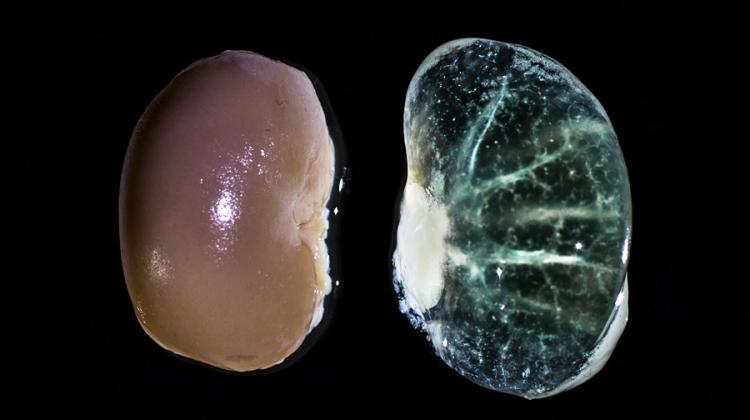See-through body: scientists discovered a way to make mice transparent

We now know how to make a prepared mouse body transparent. In addition - using genetic techniques - scientists can force selected cells to emit light. And then, nothing will escape the scientist\'s attention. Polish scientist was involved in the development of this innovative method.
Blood, water, lipids and pigments contained in the tissue make the body not translucent. It turns out that if these items are removed - tissue may become transparent as a crystal.
Scientists from Munich led by Ali Ertürk, together with Polish student Paweł Matryba have developed a method called uDISCO (ultimate 3-dimensional imaging of solvent-cleared organs http://nature.com/articles/doi:10.1038/nmeth.3964). The technique allows to prepare the body of a mouse or a rat in a way that becomes translucent to the point that if a squared paper is placed under the rodent\'s body, squares are visible through its organs. Bones, muscles, intestines, nervous system all become transparent.
Paweł Matryba studies medicine at the Medical University of Warsaw and biotechnology at the University of Warsaw. He participated in the research project in Munich as part of the within the Amgen Scholars Program scholarship. Young researcher revealed in an interview with PAP that now in Prof. Leszek Kaczmarek\'s group at the Nencki Institute he works on even more effective methods for making a body transparent.
IN ONE PIECE, NOT SLICED
Research into transparent mice would remain a mere curiosity - admittedly, the sight of the transparent body of a rodent is impressive. However, scientists have a brilliant idea how to use this transparency in practice.
The key are genetic modifications. Due to them, selected rodent cells - for example the cells of the nervous system - produce fluorescent proteins. If the tissue is illuminated with the right light in the laboratory, specific cells begin to glow, allowing to locate them.
Until now, such studies using fluorescence had fairly limited applications - opaque cells obscured the light. In histology, it was necessary to painstakingly cut tissue into thin slices and perform glowing experiments on those, layer by layer. Then, three-dimensional structures still had to be recreated in a computer.
Meanwhile, in a transparent body, no glowing cells can hide. Tissues do not have to be cut, and then stuck together again, because if they glow, they all become clearly visible. During imaging of transparent organisms prepared with uDISCO technique, all the connections between cells and the architecture of organs are clearly visible. In addition, this method does not destroy cell structures or proteins present in the body. This is sensational news for many scholars, for example those dealing with the nervous system.
Video presenting the nervous system of a mouse imaged using the uDISCO method.
"In Germany, we were able to, among other thins, image the central nervous system of mouse with a resolution allowing to see single cells over a length of 7 cm - from the top of the head to the same toe" - said Matryba. He mentioned that the technique opens the door to entirely new discoveries - the study of neurodegenerative diseases such as Alzheimer\'s disease or amyotrophic lateral sclerosis, and imaging the effects of anticancer drugs on specific organs - these are just a few of the extremely extensive list of the possibilities uDISCO offers.
HOW DOES IT WORK?
Matryba told PAP that in the German method uDISCO, body of a mouse is fixed first - to prevent cells from undergoing degradation processes. Then, a mixture of chemicals that remove blood, water and lipids is introduced into the blood. However, once these elements are removed from the body, the body inevitably shrinks. In the case of uDISCO, the volume is reduced by as much as 65 percent. Fortunately, all tissues shrink evenly, without changing proportions. "This contraction of the tissue can be very handy for scientists - smaller body is easier to scan under a microscope" - explained Paweł Matryba.
The biologist noted out that the entire process of preparation of the body in the uDISCO method takes only four days. Meanwhile, histological studies, in which subsequent tissue sections were prepared, could take months. Scientists using uDISCO will be able to study certain processes much more quickly.
The student said that there were ways to make tissues transparent even before the uDISCO method. One of the previously used methods was 3DISCO. It had, however, some drawbacks - it was impossible to image the entire body at once - glowing proteins were destroyed too quickly. "Scientists only had a few days to study glowing tissue only. With the uDISCO method, they gain a few months, and they can examine the whole body" - he explained.
CAN A MOUSE DISAPPEAR COMPLETELY?
The student admitted that the uDISCO method developed in Germany also has limitations - it is not possible to flush the blood thoroughly from all organs, which is why not every rodent tissue becomes equally transparent. There are problems, for example, with obtaining crystal clear heart or liver. The skin can not be made transparent yet either, so it must be removed during preparation. In addition, preparation must be performed under a fume hood - the substances used in the process are toxic.
That is why Paweł Matryba is already working on a more efficient method of making mice transparent. For now, the results of the work of his team are in the process of publication, so the researcher does not want to talk about details. He revealed, however, that the mouse body prepared using his technique is even more transparent, and the chemicals used in the new method less harmful, so the work does not have to be conducted under a fume hood, or using special equipment.
PAP - Science and Scholarship in Poland, Ludwika Tomala
lt/ mrt/
tr. RL
Przed dodaniem komentarza prosimy o zapoznanie z Regulaminem forum serwisu Nauka w Polsce.


















